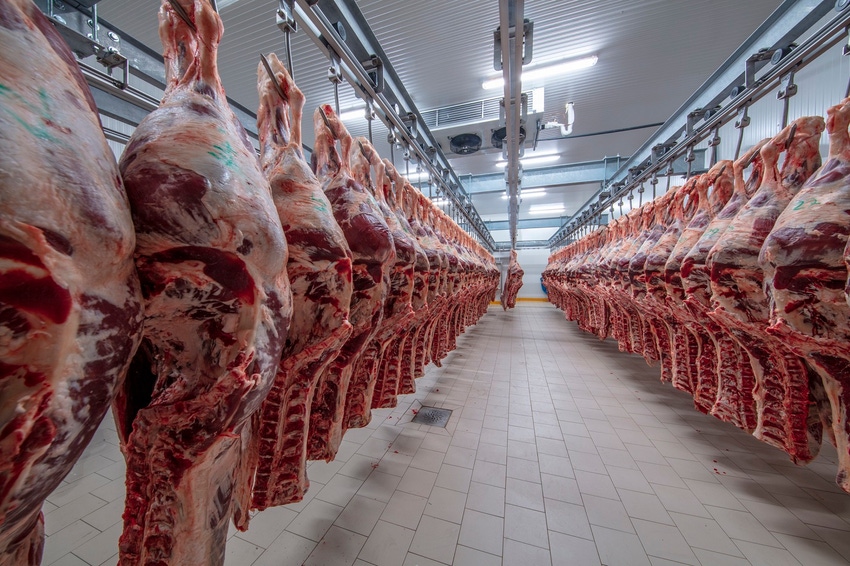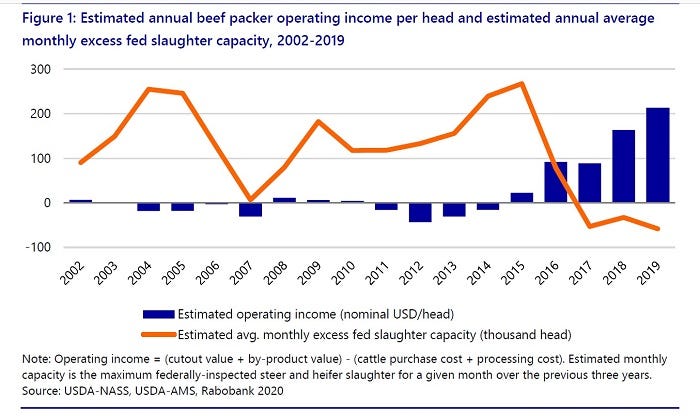
Analysts from Rabobank’s RaboResearch Food & Agribusiness group said in a new report there is room for expansion in the US beef packing industry.
In fact, they added, if the US beef industry is to stay near its current numbers and avoid a large contraction, it must add packing capacity.
“If the US can avoid major herd liquidation in the current cattle cycle, the beef industry will be well-positioned to capitalize on growing global protein demand,” they wrote. “Furthermore, improved industry stability will allow the beef sector to invest more focus and capital in its ongoing shift from an historically supply-driven market to one driven by consumer demands.”
They added that additional packing capacity would allow a larger US beef industry and “more balanced profitability” throughout the supply chain.
Their analysis says there is room for 5,000 to 6,000 head more fed cattle daily slaughter and packing capacity.
They noted there is an economic incentive for this expansion when one considers how the annual calf crop has considerably outpaced beef packing capacity and created what appear to be ample margins for the existing packers.
The report authors said in 2016 average monthly excess slaughter capacity was 78,500 head. They noted that by 2019, average monthly excess slaughter capacity had reached a negative 58,300 head.
This appears to be an ongoing situation, despite the effects of the Holcomb-plat fire and the COVID-19 pandemic.
The authors wrote: “While the Tyson-Holcomb fire and COVID-19 created acute and unexpected massive imbalances between cattle numbers and the suddenly limited availability of labor and/or facilities, the course of events over the past couple of decades had already created a scenario of relative imbalance.”

In figuring how much potential slaughter capacity the industry can use, the authors looked at monthly excess slaughter capacity together with the live-to-cutout ratio.
“With a difference in average monthly excess capacity of 136,900 head between 2016 and 2019, and assuming 24 full operating days per month, the beef industry would need to add roughly 5,700 head of daily capacity to reach the long-run average live-to-cutout ratio,” they surmised.
Tough to expand
Packers have not expanded to use this capacity, perhaps because times are good lately with excess cattle. Also, the authors say, perhaps existing packers are accustomed to the ebb and surge as capacity changes, so accumulating excess profits when times are good helps them carry through the leaner times. The authors also note the challenges of competing with established supply chain networks of existing plants, even if such a plant were opened by existing packers.
Further, the opportunity for new plants comes with heavy expense, the authors wrote. They report industry sources tell them new plants cost $100-120 million for every 1,000-head-per-day measure of capacity.
The question of exactly what could make new plants competitive is complex, the authors wrote. They discuss size and efficiency, geographic issues such as proximity to cattle supplies, feed and water, as well as socioeconomic and logistical factors and find no answers there.
Then they suggest a couple concepts that might offer enough advantage for new packers. First is additional automation that could increase efficiency. The second is specialization, perhaps by plants they call small- to medium-sized, meaning 1,000-2,000 head per day.
“Anything smaller creates real questions regarding economic viability,” they wrote. “While local lockers and micro-plants have a place in direct-to-consumer marketing, they simply don’t offer enough scale to make a measurable industry-wide impact.”
Competition for these smallest plants would be very difficult, the authors noted.
“However, if a small- to medium-sized plant can be as unique as possible by specializing in a specific product branding strategy and/or program type cattle, the value-added component may be enough to offset efficiency disadvantages.”
Such plants, they wrote, would require fewer cattle to maximize capacity utilization and fewer wholesale/retail buyers to move beef inventory. The total investment would also might less off-putting to investors.
They noted also that a new plant in Idaho aligns with such a strategy.
Ultimately, the authors wrote they believe adding 5,000 to 6,000 head per day to slaughter capacity would help “return cattle supplies and packing capacity to an historical equilibrium without a sharp contraction in beef cow numbers.”
About the Author(s)
You May Also Like




